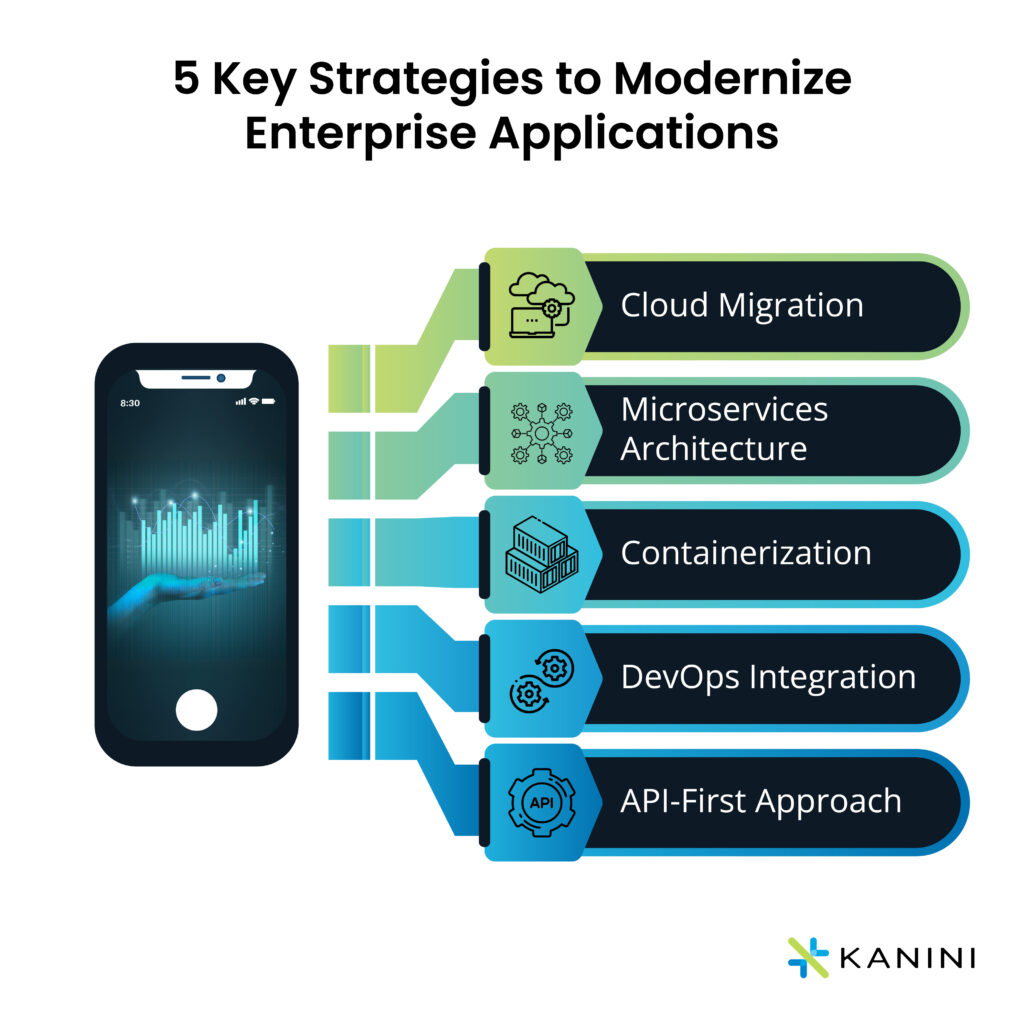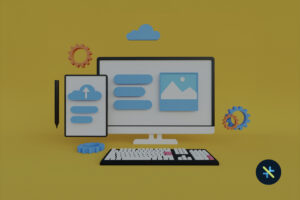Remember the days of bulky desktop computers and dial-up internet? While charming in retrospect, their limitations became painfully obvious as technology evolved. The same holds true for enterprise applications. Those once-cutting-edge systems, now creaking under the weight of outdated tech, become roadblocks to progress, threatening your business’s agility and security.
Imagine your enterprise applications as the workhorses of your business, powering critical operations and holding valuable data. But what happens when these once-mighty steeds turn old, burdened by aging technology and limited capabilities? This, unfortunately, is the reality for many organizations clinging to legacy systems. Ignoring them is like ignoring cracks in a building’s foundation – a ticking time bomb waiting to explode. This is where modernization comes into the picture.
Enterprise application modernization isn’t a luxury; it’s a strategic imperative. It’s about recognizing the limitations of your legacy systems and taking proactive steps to transform them into agile, secure assets that support your business goals. It’s not about ripping everything out and starting anew; it’s about choosing the right approach, whether it’s rehosting, refactoring, or embracing microservices.
In this blog post, we’ll explore the challenges of legacy enterprise applications, different modernization strategies, and equip you with the knowledge to make informed decisions.
Table of Contents
The Challenges from Using Outdated Enterprise Applications
Legacy enterprise applications pose significant challenges to security, scalability, integration, maintenance, and user experience.
- Security: Outdated applications lack modern security features, exposing your data to cyberattacks and breaches. Imagine the financial and reputational damage of a major data leak!
- Scalability: As your business expands, your enterprise apps might struggle to keep pace, hindering your ability to serve new customers and enter new markets. Growth becomes an uphill battle.
- Integration: Connecting legacy systems with newer technologies is akin to fitting square pegs into round holes – a frustrating, inefficient process that hampers collaboration and innovation.
- Maintenance: Skilled professionals can still work with these aging systems are becoming increasingly scarce and expensive, diverting resources from strategic initiatives.
- User Experience: Clunky interfaces and limited functionalities frustrate employees, leading to decreased productivity and hindered innovation. A demotivated workforce is a recipe for decline.
These challenges, if left unchecked, threaten to erode the very foundation of your business, hindering growth, innovation, and jeopardizing your competitive edge.
The decision to modernize your enterprise applications isn’t always an easy one. After all, legacy systems often seem very familiar to use, even if they’re clunky and outdated. But the truth is, clinging to them comes at a hidden cost, hindering your business’s growth and threatening its future. That is why modernization is important. So, how do we modernize?

Key Strategies to Enterprise Application Modernization
We’ve established the transformative potential of enterprise application modernization, but how do you translate that into reality? Here are the essential strategies that will equip you to modernize your enterprise applications and propel your business into the future:
- Cloud Migration: Everyone knows the days of bulky, on-premise servers demanding constant maintenance? Migrating your applications to the cloud offers a breath of fresh air. Think of it like moving from a cramped office into a spacious co-working space – the cloud provides flexibility, scalability, and accessibility you never imagined. No more struggling with limited storage or worrying about hardware upgrades. The cloud offers reduced infrastructure costs, automatic updates, and seamless collaboration across teams, all powered by its vast resources.
- Microservices Architecture: Microservices architecture dismantles monolithic applications, breaking them down into smaller, more manageable units – think of it like modular apartments within a complex. This approach makes maintenance a breeze – you can update or fix specific sections without impacting the entire system. It also enables independent scaling, allowing you to easily adjust resources based on specific functionalities. The cherry on top? Microservices foster continuous integration and deployment, allowing you to push updates faster and more efficiently.
- Containerization: Remember packing for a trip and having everything you need neatly organized in separate containers? Containerization works similarly for your applications. Tools like Docker package your application and its dependencies into self-contained units, ensuring consistent performance across different environments. Whether you’re deploying on-premises or in the cloud, your application behaves the same way. This speeds up development cycles and enhances portability, allowing you to easily move your applications between environments without worrying about compatibility issues.
- DevOps Integration: Recall the frustrating communication gaps between development and operations teams, often working in silos? DevOps bridges that gap, fostering collaboration and communication between these critical groups. Imagine a world where automated testing, continuous integration (CI), and continuous deployment (CD) work hand-in-hand. With CI, code changes are automatically tested to ensure functionality, while CD automates the deployment process, eliminating manual errors and speeding up delivery. This collaborative approach leads to reliable applications delivered at an unprecedented pace.
- API-First Approach: APIs are the bridges connecting your applications and systems. An API-first strategy ensures these bridges are built for seamless communication, promoting interoperability and easy integration with other systems. Imagine your CRM data seamlessly flowing into your marketing automation platform, or your sales team accessing real-time inventory data – all thanks to well-defined APIs. This creates a connected ecosystem, both within your organization and beyond, facilitating data flow, boosting efficiency, and fostering innovation.
By using all these strategies in your enterprise application modernization initiatives, you’ll be able to build modern, agile applications that empower your business to thrive in the digital age.
What to Do After Modernizing Enterprise Applications?
Modernization isn’t a one-time event; it’s a continuous process that requires ongoing commitment and strategic evolution. Here’s how to ensure your modernized applications remain valuable for years to come:
- Monitor and Measure: Continuously monitor the performance and usage of your modernized applications. Use these insights to identify areas for improvement and ensure your applications are delivering the expected value.
- Foster a Culture of Innovation: The agility gained through enterprise app modernization shouldn’t lie dormant. Encourage your teams to experiment, explore new technologies, and continuously improve your applications.
- Prioritize Security: The threat landscape is constantly evolving. Regularly update your applications, implement robust security protocols, and conduct penetration testing to identify and address potential weaknesses.
- Upskill Your Workforce: Modern applications require modern skills. Equip your employees with the necessary training and resources to leverage the full potential of your modernized applications.
- Stay Informed and Adapt: The technology landscape is dynamic. Stay updated on emerging trends, new technologies, and best practices relevant to your applications and industry. Be prepared to adapt your modernization strategy as needed to ensure your applications remain competitive and relevant. Continuous learning is crucial for sustainable success.
Getting Started
By following these steps, you’ll ensure your modernization journey doesn’t end with deployment. This will enable your applications to evolve alongside your business needs and remain as valuable assets for the future.
Ready to transform your legacy enterprise applications? KANINI’s experts bring the know-how and tools to guide you through your modernization journey, from strategy to implementation and beyond. Contact us today and let’s build your digital future, together.
Author

Muruganandham
Muruganandham is a lead application developer at KANINI in the iOS & MacOS space. His passion for app architecture and innovative mobile applications is very much visible in his collaborative approach, working closely with designers, product owners, and developers to create exceptional user experiences. With 10+ years of experience in app development across GIS, Utility, and Social Media apps, Muru is specialized in combining technical proficiency with a refined UI/UX sensibility.








